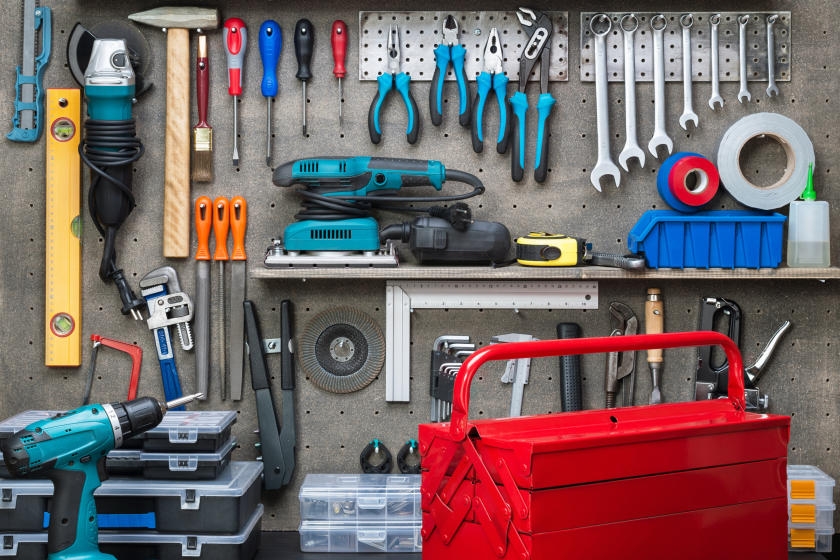If you take care of your tools, they will return the favor. Proper care and routine maintenance of your hand tools and power tools makes any home improvement or repair project easier, safer and more successful. Proper tool care also saves you money because the better they’re cared for, the longer they’ll last.
Hand Tools
Hand tools such as screwdrivers, wrenches, hammers, pliers, levels, and wire cutters are examples of common household tools that are often left out in places such as basements, garages and tool sheds. Tools are tough, but they are not indestructible and exposure to the elements can take its toll.
Below are some tips on how to take care of your tools and store them properly so that you get optimum use out of them.
Clean, Inspect and Care for Tools
Make it a habit to clean tools after each use before you return them to storage. Wipe them down with a rag or old towel and be sure they are free of dust, grease and debris before you put them into their proper places. This is also an opportunity to look for any damage or defects. Check your tools’ handles for splinters, breaks and cracks. Also, make sure that metal parts show no signs of corrosion or rust. Repair or replace any tools that show signs of damage.
Cold chisels, log-splitting wedges and other striking tools can be very dangerous if they are not maintained properly. Because these types of tools are used for repeated striking, the surface of the metal head eventually mushrooms out and spreads to form a lip or ridge around the edge. With continued use, there is more spreading and the metal lip may continue to thin, split or curl until it finally breaks. If the metal head separates from the handle while in use, this could result in a dangerous projectile. To prevent this hazard, just grind off the metal edges with a powered grinder on a regular basis.
Safety Alerts!
Don’t use tools that need repair or replacement. Broken tools can cause injury.
Don’t use tools inappropriately; you risk injury to yourself, others and damage to the tools.
After cleaning, use an all-purpose oil, such as WD-40® to lubricate tools with adjustable parts. Lightly spray other metal tool parts as well (avoid getting oil on handles), such as screwdrivers and bladed lawn and garden tools. Wipe away any excess with a rag before storing. This will help fight corrosion and rust.
If your tools already show signs of rust, there are a number of rust removers available at True Value, such as Evapo-Rust Rust Remover. You can also try spraying tools with WD-40® and then scrubbing them with steel wool or a stiff wire brush. Afterwards, wash them with warm, soapy water and scrub them again with a cloth or rag until all signs of rust are gone. Then dry them thoroughly with a clean, dry rag. Apply a light coat of WD-40® and wipe away excess oil before storing.
Safety Alert!
You should wear heavy gloves when cleaning or removing rust from tools that can cut. Wear safety goggles when using a wire brush to remove rust.
Smooth weathered, rough wooden handles with a medium-grit emery cloth. Handles should be smooth enough to slide your hand along. If the wood is very rough, first sand across the grain in a shoe-shine fashion. Finish by sanding with the grain. Wipe a dry handle down with a heavy coat of linseed oil to rejuvenate and protect the wood.
Bladed tools, such as shovels, pruners and other lawn and garden tools should be sharpened once per season. Use files to sharpen digging tools and to sharpen nicked or dull cutting tools. For digging tools, file the working edge to a 45-degree bevel with a coarse file. Hone and maintain the sharp edge of all cutting tools with a medium-grit sharpening stone. For faster cutting, wet the stone with water or lubricate it with honing oil depending on the type of stone you have.
Store Tools Properly
A proper storage system is a must for hand tools. A toolbox, storage container, shelving unit, or a combination of all of these can be used to keep your tools protected and in peak condition. Ideally, your storage units should be kept somewhere with minimal exposure to moisture and temperature changes. Remember to keep tools in their respective places or hung on designated hangers when a job has been completed.
Helpful Tips
Use a small tool bag for the tools you use most often such as tools for simple jobs around the house. The rest of your tool arsenal can remain in your main toolbox.
You should have a space where you can inspect your tools and perform necessary maintenance tasks, such as a worktable. Cover it with newspaper or plastic sheeting to protect the table and make it easier to clean up after you’re done with the job.
Hang lawn and garden tools, such as shovels and rakes, on a wall to get them off of the ground and to protect them from moisture.
Power Tools
Power tools such as electric drills, saws, sanders and nailers need routine maintenance just like your hand tools. Because of their mechanical and electrical parts, power tools are more susceptible to problems caused by poor maintenance, dust and debris accumulation and general malfunction. The following are some helpful tips on how to clean and properly store your tools.
Keep Power Tools Clean
Dust and grime can bring your power tools to a grinding halt if left unchecked over time. Wipe them clean with a rag after every job has been completed and then store them. Deep clean periodically by using a damp cloth. Get into exhausts and intakes and other hard-to-clean areas with lightly oiled cotton swabs or other slender tools.
Helpful Tip
Using an air compressor or a can of compressed air to blow air into vents and crevices is the best way to remove dirt and dust from inside tools.
For tools that use filters, replace the filters as specified by the manufacturer’s instructions.
Store Power Tools Correctly
Keep your power tools protected from dust, moisture and other adverse conditions by storing them properly after use. Keep them in their original cases if possible, or tuck them away in storage drawers or tool chests, preferably in a garage or basement with a moderately controlled climate. This not only protects them, it also keeps them organized so you can easily find the tool you need when you need it.
Helpful Tip
Remember to keep instruction manuals for all of your tools. They are provided to you by the manufacturer so that you can safely and competently operate your tools. They’ll also have valuable information on how to care for the tool, find replacement parts and other important pieces of information. Store manuals either in a toolbox drawer or a cabinet in your workspace/storage area so that they are readily available.
Inspect for Wear or Damage
Periodically inspect power tools for any signs of wear or damage. Pay special attention to power cords. If you see frayed insulation or exposed wires, have the cord repaired or replaced immediately by a professional, unless you have the expertise to do it yourself. Damaged power cords can potentially lead to injury from electric shock or can cause a fire. Also, check the cord’s prongs to see if they are bent or loose. If any are, repair or replace.
Safety Alert!
Always unplug electric tools when cleaning them or making any repairs to avoid the danger of electric shock. It’s also a good practice to unplug them when not in use.
Lubricate Moving Parts
Keep moving parts lubricated for premium performance. Not only does it keep the mechanics of a tool running smoothly, it also decreases the chance of rust developing. While common machine oil is a good choice, consult your owner’s manual to see if the manufacturer recommends or requires a specific type of oil.
Keep Batteries in Shape
Cordless, battery-powered tools are convenient and portable and have become very popular for contractors and homeowners alike. To keep them running efficiently and effectively, it is essential for their batteries to be maintained.
Batteries remain working at peak level by fully charging and then fully discharging their power once every couple of weeks. Don’t let batteries sit unused for extended periods of time. Try to use batteries once every two weeks.
Care for batteries by cleaning contacts with cotton swabs and alcohol. Store batteries you won’t be using for a while in a dry, clean place away from excessive heat.
That’s it! Follow these general steps and your tools should last for years.
Project Shopping List
Here’s what you’ll need to complete this project successfully.
- Rag, cloth or old towel
- All-purpose oil such as WD-40®
- Rust remover (optional)
- Steel wool
- Stiff wire brush
- Heavy gloves
- Safety goggles
- Medium-grit emery cloth
- Linseed oil
- Coarse file
- Medium-grit sandpaper
- Honing oil
- Toolbox
- Shelving unit
- Tool storage container
- Tool bag
- Newspaper
- Plastic sheeting
- Mild detergent
- Cotton swabs
- Air compressor
- Alcohol












